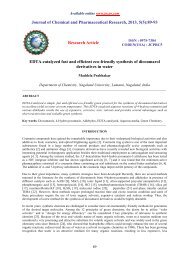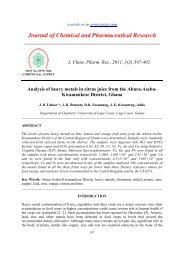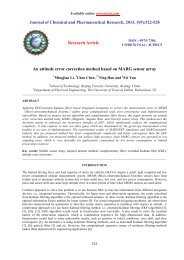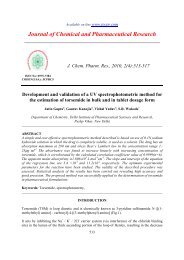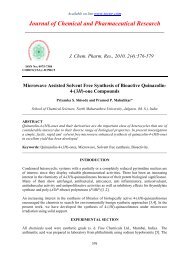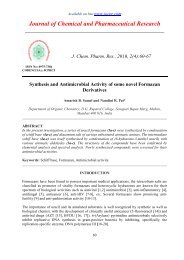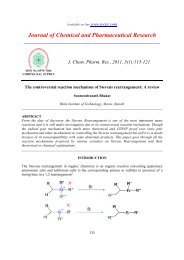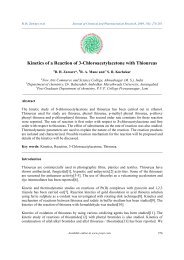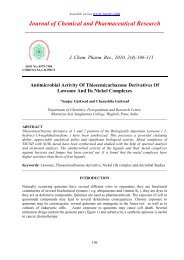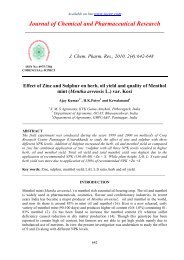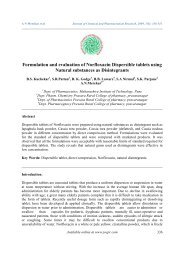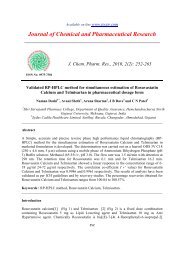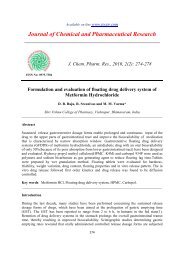Three analytical methods for determination of Epinastine ...
Three analytical methods for determination of Epinastine ...
Three analytical methods for determination of Epinastine ...
You also want an ePaper? Increase the reach of your titles
YUMPU automatically turns print PDFs into web optimized ePapers that Google loves.
Ramzia I. El-Bagary et al J. Chem. Pharm. Res., 2012, 4(2):1361-1369______________________________________________________________________________Table (1): Optimum assay parameters <strong>for</strong> the three proposed <strong>analytical</strong> <strong>methods</strong> <strong>of</strong> EPHParameters Difference method Colorimetric method HPLC methodInstrumental parameters-Wavelength range: 400-200 nm.-Recording range: 0 to 2.-spectral band width: 2nm-Sampling interval: auto-Wavelength range: 800-200 nm-Ordinate range limit: 0 to 2.-scanning speed: fast-Scanning speed: fastWavelength<strong>of</strong>measurement (nm)252 517 262Optimizedparametersexperimental-Time <strong>of</strong> reaction: 0 min-Stability <strong>of</strong> the color: 30 min-Drug: Reagent volume ratio : 1:6-Solvent used: acetonitrilemethanolmixture.RESULTS AND DISCUSSION-Stationary phase: lichrocart 10 µmC18 column-Flow rate: 1 ml/min-Mobile phase: acetonitrile:0.1 Mammonium acetate buffer(40:60 v/v)3.1. For Difference method:This work describes a simple pH-induced difference spectrophotometric method <strong>for</strong> the <strong>determination</strong> <strong>of</strong> EPH in eyedrops. The absorbance spectra <strong>of</strong> equimolar solutions <strong>of</strong> EPH in 0.1 N HCl and 0.1 N NaOH, are shown in fig. (1).Fig. (1). Absorption spectra <strong>of</strong> equimolar solution <strong>of</strong> EPH (96 µg.ml -1 ) in 0.1 N NaOH alone (____) , in 0.1 NHCl (------) alone and the difference absorption spectrum <strong>of</strong> equimolar solution <strong>of</strong> EPH ( 96µg.ml -1 )in 0.1 NNaOH vs 0.1 N HCl (……….).Fig.(1) shows the difference absorption spectrum <strong>of</strong> EPH solution in 0.1 N NaOH (in sample cell) against itsequimolar solution in 0.1 N HCl (in reference cell) where it was found that measurements <strong>of</strong> absorbance differenceat 252 nm were quantitatively proportional to EPH concentration. A plot <strong>of</strong> absorbance difference values versusEPH concentration was found to be linear over the concentration range <strong>of</strong> (16-96 µg.ml -1 ,r 2 = 0.9994). The limit <strong>of</strong>detection (LOD) and limit <strong>of</strong> quantitation (LOQ) were calculated and described in Table (2). The obtained spectra <strong>of</strong>the eye drops solution were compared to those <strong>of</strong> the standard drug where both spectra were found to be identical.Difference spectrophotometric method was applied to estimate the concentration <strong>of</strong> EPH in bulk and in“Relestat”eye drops applying the standard addition technique and the obtained results were recorded in Tables (3,8).3.2. For colorimetric method:EPH solution in methanol shows an absorption band at 262 nm as shown in Fig. (2) while CAA in acetonitrilesolution gives a prominent peak at 439 nm. However, on reaction <strong>of</strong> both compounds, a new absorption peak is<strong>for</strong>med at 517 nm as shown in Fig. (2) as a result <strong>of</strong> the <strong>for</strong>mation <strong>of</strong> charge-transfer complex. This colorimetricmethod is based on the <strong>determination</strong> <strong>of</strong> EPH through the <strong>for</strong>mation <strong>of</strong> a charge-transfer complex betweenchloranilic acid which reacts as a Π -acceptor and the studied drug as n-donor in an (acetonitrile-methanol mixture)as shown in Fig.(3). EPH contains two aromatic rings that serve as n-electron donor moieties.1364



